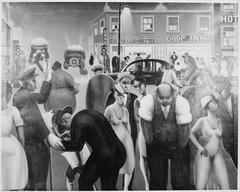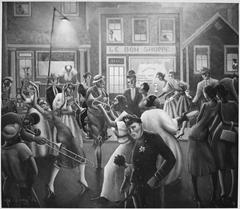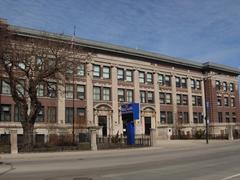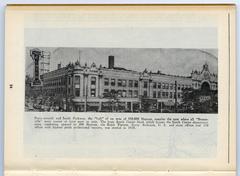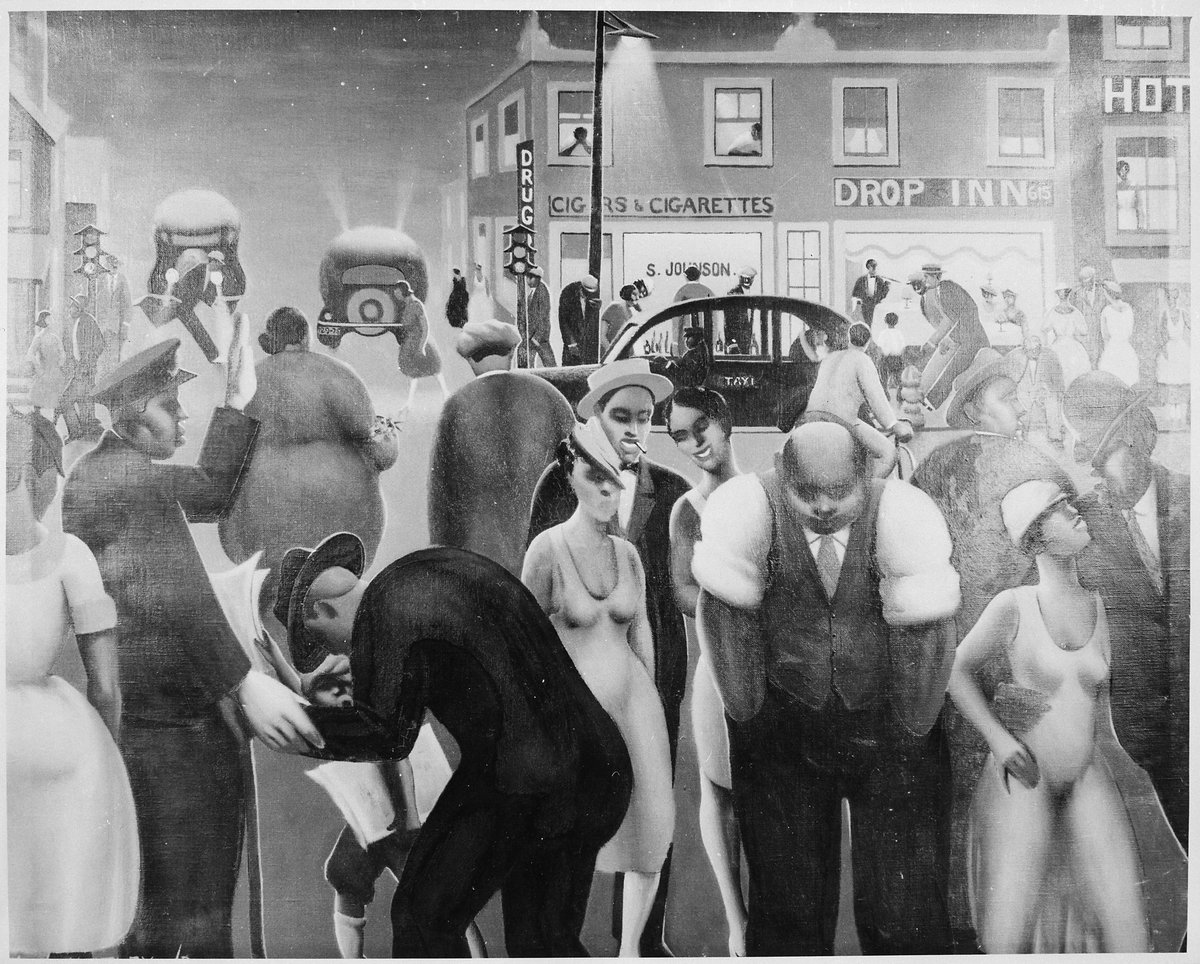
Bronzeville Chicago Visiting Hours, Tickets, and Historical Sites Guide
Date: 14/06/2025
Introduction: Experience the Legacy of Bronzeville
Bronzeville, often called Chicago’s “Black Metropolis,” is a vibrant neighborhood that stands as a living monument to African American achievement, culture, and resilience. Located on Chicago’s South Side, Bronzeville rose to prominence during the Great Migration, when waves of Black families arrived seeking opportunity and freedom. This influx transformed Bronzeville into a national center of Black business, music, social activism, and the arts—rivaling Harlem in its influence on American culture.
Today, Bronzeville remains an essential destination for anyone interested in history, architecture, music, and the ongoing story of Black Chicago. Visitors will encounter historic landmarks, lively arts venues, culinary treasures, and welcoming community institutions. This guide provides comprehensive, up-to-date information on Bronzeville’s historical significance, visiting hours, ticketing, transportation, accessibility, safety, and more—ensuring a rewarding experience for every guest.
For further insights and the latest updates, consult resources like the IIT Bronzeville History Booklet and the Chicago Beautiful Bronzeville Guide.
Contents
- Bronzeville’s Historical Overview
- Cultural Significance and Landmarks
- Visitor Essentials: Hours, Tickets, and Accessibility
- Guided Tours, Festivals, and Events
- Dining, Art, and Community Life
- Getting Around: Transportation and Parking
- Safety and Travel Tips
- Frequently Asked Questions (FAQ)
- Recommended Resources and Further Reading
Bronzeville’s Historical Overview
Indigenous and Early Settlement Roots
Before the Great Migration, the land that became Bronzeville was home to Indigenous peoples such as the Potawatomi, Miami, and Illinois tribes, who thrived along Lake Michigan’s southwestern shores (IIT Bronzeville History Booklet). European settlement in the 19th century led to rapid urban expansion and major demographic shifts.
The Great Migration and the Rise of Bronzeville
Bronzeville’s defining era began with the Great Migration (1916–1970), as hundreds of thousands of African Americans moved from the South to Chicago. By 1930, the city’s Black population soared, with most settling in the “Black Belt”—the heart of present-day Bronzeville (IIT Community Affairs). Despite facing housing discrimination and segregation, residents built a powerful “city-within-a-city” complete with thriving businesses, churches, and schools (Build Bronzeville).
The Black Metropolis: Economic and Cultural Flourishing
Bronzeville’s heyday (1920s–1940s) saw the neighborhood blossom as a hub for Black commerce, arts, and activism (IIT Community Affairs). Noteworthy institutions included:
- Binga Bank: Chicago’s first Black-owned bank.
- Supreme Life Insurance Company: A pioneering Black-owned insurer.
- Chicago Defender and Chicago Bee: Influential newspapers advancing civil rights.
Bronzeville was also a center for medical innovation—Dr. Daniel Hale Williams performed groundbreaking heart surgery at Provident Hospital, America’s first Black-owned hospital.
Artistic Legacy: Music, Nightlife, and Literature
Bronzeville’s “Stroll” (State Street) became legendary for its jazz clubs and theaters, drawing icons like Louis Armstrong and Nat King Cole (IIT Community Affairs). The neighborhood fostered gospel, blues, and the Black Arts Movement, and was home to literary greats such as Gwendolyn Brooks and Lorraine Hansberry (Chicago Beautiful).
Community Power and Social Progress
Bronzeville’s churches, civic groups, and the Wabash Avenue YMCA (birthplace of Black History Month) played pivotal roles in political advocacy and community support (IIT Community Affairs).
Challenges, Decline, and Revitalization
Urban renewal, expressway construction, and population decline—from post-WWII through the late 20th century—brought significant challenges (IIT Bronzeville History Booklet). Today, Bronzeville is undergoing a renaissance, with historic preservation, new businesses, and vibrant cultural programming restoring its legacy (CMAP).
Cultural Significance and Landmarks
National Heritage and Architectural Landmarks
Bronzeville boasts nine official Chicago landmarks within the Black Metropolis–Bronzeville District, including:
- Wabash Avenue YMCA: Birthplace of Black History Month.
- Chicago Bee Building: Art Deco headquarters of the influential Black newspaper.
- Overton Hygienic Building: Center of Black entrepreneurship.
- Pilgrim Baptist Church: Birthplace of gospel music.
Most sites are viewable from the exterior at any time; some buildings offer tours by appointment. (See voices.uchicago.edu)
The Stroll (State Street)
State Street’s historic entertainment district is commemorated by plaques and public art, with guided tours available through organizations like Chicago Detours.
Bronzeville Art District
A hub for Black visual art, the district encompasses:
- Gallery Guichard: African Diaspora exhibitions and sculpture garden.
- Faie Afrikan Art: Traditional and contemporary African art.
- Blanc Gallery: Contemporary works and community dialogue.
- South Side Community Art Center: The nation’s oldest Black art center (currently under renovation in 2025).
The Bronzeville Art District Trolley Tour (June–September) offers free monthly hop-on/hop-off rides connecting key venues.
Visitor Essentials: Hours, Tickets, and Accessibility
Visiting Hours
- Outdoor Landmarks & Murals: Accessible at all times.
- Museums & Galleries: Typically open Tuesday–Sunday, 10 a.m.–5 p.m. (Some may vary; check specific sites.)
- Bronzeville Visitor Information Center: 9 a.m.–5 p.m., Monday–Saturday (The Tourist Checklist).
Tickets
- Most outdoor sites and walking tours are free.
- Museums and special exhibitions may require tickets ($5–$15).
- Guided tours (e.g., Chicago Mahogany Tours) and art trolley tours may require advance booking or ticket purchase.
Accessibility
- Major venues, galleries, and public spaces are generally wheelchair accessible.
- The CTA Green and Red Lines (e.g., 35th-Bronzeville-IIT, Sox-35th) and buses serve the neighborhood.
- Contact individual venues for accommodations if you have specific accessibility needs.
Guided Tours, Festivals, and Events
Guided Tours
- Chicago Mahogany Tours: Two-hour explorations of Bronzeville’s history and architecture, led by urban historian Sherman “Dilla” Thomas.
- Bronzeville Historical Society Tours: Focused on oral histories and preservation (Bronzeville Archives).
- Bronzeville Art District Trolley Tours: Family-friendly, free trolley tours connecting local galleries during summer months.
Annual Events
- Bud Billiken Parade: The nation’s largest African American parade.
- Juneteenth Celebrations: Live music, cultural performances, and guided history tours (Secret Chicago).
- Palm Sundays Concert Series: Jazz and blues in the Gallery Guichard Sculpture Garden.
Check with the Bronzeville Visitor Information Center for the latest event schedules.
Dining, Art, and Community Life
Culinary Hotspots
- Peach’s on 47th: Soul food classics and brunch favorites.
- Yassa African Restaurant: Authentic Senegalese cuisine.
- Shawn Michelle’s Homemade Ice Cream: Southern-inspired flavors (Eater Chicago).
- Bronzeville Soul: Family-owned, specializing in comfort food (Monaghan SRVC).
- Turner Haus Brewery: Chicago’s first Black-owned taproom.
Reservations are recommended for popular venues, especially on weekends.
Community and Wellness Spaces
- Haji Healing Salon: Yoga, acupuncture, and holistic wellness.
- Little Black Pearl: Arts center offering classes and exhibitions (hiusa.org).
Notable Streets and Public Art
Explore 35th, 43rd, and 47th Streets for murals, historic architecture, and vibrant commercial life. The Great Migration Sculpture Garden honors the journeys of Black Chicagoans.
Getting Around: Transportation and Parking
- CTA Green and Red Lines: 35th-Bronzeville-IIT and Sox-35th stations serve the area.
- Bus Routes: #3 King Drive, #29 State Street, and others.
- Parking: Street parking is available but limited; check signage for restrictions.
- Walkability: Bronzeville is highly walkable, with most attractions close together (The Tourist Checklist).
Safety and Travel Tips
Bronzeville is well-patrolled and considered safe around major attractions, especially during the day. Exercise standard urban precautions:
- Stay in well-lit, busy areas.
- Secure valuables and remain aware of your surroundings.
- Use public transportation or reputable rideshares for late-night travel (Timeless Travel Steps; The Broke Backpacker).
Frequently Asked Questions (FAQ)
Q: What are typical visiting hours for Bronzeville attractions?
A: Most museums and galleries operate 10 a.m.–5 p.m., Tuesday–Sunday. Outdoor landmarks are accessible at all times. Always verify specific sites for seasonal hours.
Q: Are tickets required for tours or historical sites?
A: Many outdoor sites and landmarks are free. Some guided tours and special exhibitions require advance ticket purchases.
Q: Is Bronzeville accessible by public transportation?
A: Yes, via CTA Green and Red Lines and multiple bus routes.
Q: Are the attractions accessible to people with disabilities?
A: Most major venues and public spaces are wheelchair accessible. Contact providers for details.
Q: When is the best time to visit for events?
A: May–September features major events such as trolley tours and music festivals.
Recommended Resources and Further Reading
- IIT Bronzeville History Booklet
- IIT Community Affairs: Bronzeville History
- Chicago Beautiful Bronzeville Guide
- Chicago Cultural Center Bronzeville Echoes Exhibition
- Chicago Metropolitan Agency for Planning: Black Metropolis National Heritage Area
- The Tourist Checklist: Bronzeville Chicago
- Choose Chicago: Bronzeville Neighborhood Guide
- Eater Chicago: Best Restaurants in Bronzeville
- Monaghan SRVC: Top Restaurants in Bronzeville
- Timeless Travel Steps: Safety in Chicago
- The Broke Backpacker: Is Chicago Safe?
Plan Your Visit to Bronzeville
Immerse yourself in Bronzeville’s rich history, vibrant art, and community spirit. Download the Audiala app for guided audio tours and local insights, and follow our social media channels for the latest news and event updates. Whether you’re a history buff, foodie, art lover, or simply curious, Bronzeville welcomes you to experience its enduring legacy and lively present.
